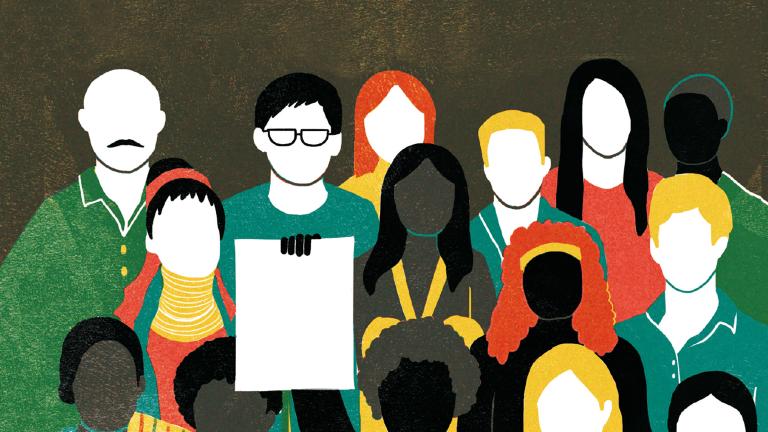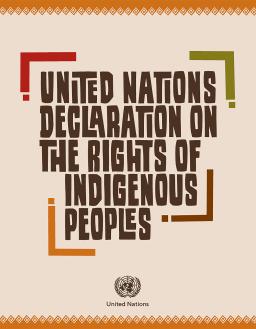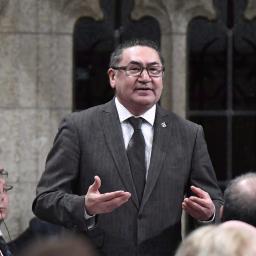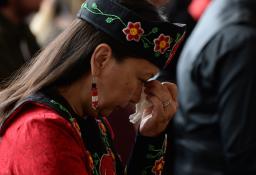What is the United Nations Declaration on the Rights of Indigenous Peoples (UNDRIP) and why is it important? What does Canada’s commitment to enact UNDRIP mean? How will it impact treaty rights, land, resources and cultural rights in Canada?
The United Nations Declaration on the Rights of Indigenous Peoples
The struggle to recognize Indigenous rights in Canadian law
By Karine Duhamel
Published: September 8, 2022
Tags:

Illustration: Boyoun Kim
Story text
On June 21, 2021, the United Nations Declaration on the Rights of Indigenous Peoples Act received royal assent in Canada. It declares that the laws of Canada will be made consistent with UNDRIP. It affirms UNDRIP as an important source for interpreting Canadian law. And it sets out timelines for the government to create and implement an action plan “to achieve the objectives of the Declaration.”
In a joint statement, Justice Minister David Lametti and Minister of Crown‐Indigenous Relations and Northern Affairs Carolyn Bennett called this a “critical step in recognizing, promoting, protecting and upholding the human rights of Indigenous Peoples in Canada.” They said: “It […] will help forge stronger relationships and support the path of self‐determination for First Nations, Inuit and Métis.”
This important achievement took nearly 25 years of work. UNDRIP’s implementation in Canada could be transformative for Indigenous rights.

What is the United Nations Declaration on the Rights of Indigenous Peoples?
UNDRIP is a human rights instrument that sets out the rights of Indigenous peoples around the world. Human rights instruments include declarations, conventions and treaties intended to define and uphold human rights in international law. Many, such as UNDRIP, are not legally binding. Instead, they provide authoritative ideas and approaches that can influence state laws and practices.
The Declaration contains 46 articles describing a variety of collective and individual rights. It identifies states and governments as responsible for protecting and upholding these rights. Its goal is to defend the survival, dignity and well‐being of Indigenous people.
Existing international human rights instruments already apply to Indigenous peoples. But UNDRIP makes an important case that they may need special protections. It defines specific rights related to Indigenous identities, livelihoods and ways of knowing and being in the world.
Indigenous peoples and individuals are free and equal to all other peoples and individuals and have the right to be free from any kind of discrimination.
The key rights set forth in UNDRIP
The central themes of UNDRIP include:
- the right to self‐determination;
- the right to be recognized as distinct peoples;
- the right to free, prior and informed consent;
- the right to be free from discrimination.
The core matter of self‐determination affirms the right of Indigenous peoples to decide what is best for their communities and to carry out those decisions in ways that are meaningful to their people. This includes respecting existing treaty relationships and invites the negotiation of new agreements.
The Declaration includes protections for cultural rights, such as preserving Indigenous languages and religions. Many Indigenous languages are on the verge of being – or have already become – extinct. Similarly, many Indigenous cultural and religious practices have been violently suppressed worldwide by Christian colonial rule for centuries. They require specific and special protection.
The Declaration also includes rights to lands, territories, resources and the environment. It supports rights to self‐determination in key areas such as legal systems, health and education. UNDRIP calls on states to create effective mechanisms to address human rights violations. This includes redress for attacks on Indigenous peoples’ identity, integrity and self‐determination.

Negotiating and endorsing the Declaration
UNDRIP took nearly 25 years to negotiate. The process involved hundreds of UN member states and groups of Indigenous peoples from around the world. Indigenous leaders based in Canada played an important role.
The path was not always an easy one. For instance, several nations, including Canada, expressed concern that the protections would contradict national laws. When the UN General Assembly voted on the Declaration in 2007, Australia, Canada, New Zealand and the United States voted against adopting it. All these countries have notable colonial histories involving rights violations against Indigenous peoples.
Canada later endorsed UNDRIP in November 2010, but only as an aspirational document. In May 2016, the government of Canada announced its full support for the Declaration. Minister Bennett said: “What is needed is fundamental and foundational change. It’s about righting historical wrongs. It’s about shedding our colonial past. It’s about writing the next chapter together as partners.”
Dr. Wilton Littlechild has been a key champion for the Declaration in Canada. Dr. Littlechild is a Cree Chief, residential school survivor and lawyer. He has devoted himself to the development of the Declaration and to the advancement of the rights of Indigenous peoples around the world.
According to Dr. Littlechild, the Declaration gives Indigenous peoples an important international voice. “In our quest for recognition and justice, we actually contributed a lot into the UN family and humankind,” he says. “It was Indigenous peoples who brought to the floor the need to recognize family, the need to recognize Indigenous law.”

Implementing UNDRIP in Canada
Romeo Saganash introduced a private Member’s bill to implement UNDRIP in Canada in April 2016. Saganash is a prominent Cree lawyer who was a Member of Parliament representing northern Quebec. His proposed legislation was Bill C‑262, An Act to ensure that the laws of Canada are in harmony with the United Nations Declaration on the Rights of Indigenous Peoples. In one of his many speeches on Bill C‑262, Saganash said: “If you believe in reconciliation, what are you doing about it?… There cannot be reconciliation in the absence of justice.”
Saganash’s bill was widely supported in the House of Commons. It passed its 3rd reading in 2018 with a vote of 206 for and 79 against. But in 2019, the clock ran out on Bill C‑262 in the Senate. The bill had passed through two Senate readings and a committee review. However, the Senate failed to pass it before summer adjournment – which took place on National Indigenous Peoples’ Day, no less.
For Saganash and other supporters, the failure of the Senate to pass the bill demonstrated its lack of commitment to UNDRIP. Many doubted whether UNDRIP would ever have application in Canadian law.

But it did. In 2019, the government built on the support Indigenous groups had offered for Bill C‑262. After discussions with Indigenous partners, they used Bill C‑262 as the basis for a new legislative proposal. Justice Minister David Lametti introduced and sponsored Bill C‑15 in 2020. By June of 2021, it had become law.
The new law mandates key actions with respect to UNDRIP. It requires the federal government to ensure Canadian laws are consistent with the Declaration. It also requires the government to prepare and implement an action plan to achieve its objectives within two years. Annual progress reports towards the implementation of UNDRIP are also required.
Now people, as they implement the UN Declaration, are feeling a sense of justice, a sense of healing from the past harm.
What now for Canada?
As a Declaration, UNDRIP was seen by many as non‐binding. It was considered strong in principle but weak in application. The enactment of UNDRIP into Canadian law through Bill C‑15 raises profound questions about the structures and realities of colonialism in Canada.
The rights set forth in the Declaration will present challenges to many systems, policies and practices in Canada. For example, the right to free, prior and informed consent could affect resource extraction currently taking place on Indigenous lands without such consent. The ongoing over‐apprehension of Indigenous children by social services contradicts protections in UNDRIP. The lack of basic infrastructure and services – such as clean water – in many Indigenous communities flies in the face of a declaration that demands equal access, treatment, opportunity and well‐being.
Concepts like free, prior and informed consent appear throughout the Declaration. They present important opportunities to do things differently. Bill C‑15 is, as Ministers Lametti and Bennett point out: “The foundation for transformational change in Canada’s relationships with Indigenous Peoples.” Indeed, UNDRIP fundamentally challenges the systems of dispossession upon which Canada was built.
There are many doubts about the likelihood of this transformation. Centuries of rights violations have taught many Indigenous people to fear laws that promise much but deliver little. Ongoing rights violations in the absence of recourse invite doubt that yet another new process will change anything. Bernie Williams – a powerful advocate for missing and murdered Indigenous women, girls and 2SLGBTQ+ people – points out that the provisions of UNDRIP clearly identify many ongoing violations against Indigenous women and children, “and yet nothing’s done.”

But for others, UNDRIP’s enactment into Canadian law may signal a brighter future. While much remains to be seen around how Bill C‑15 is applied, its passage matters. Jean Leclair, professor of constitutional law at the Université de Montréal, testified before the National Inquiry into Missing and Murdered Indigenous Women and Girls in 2018. He said: “It will not produce social reality on its own, but it’s a great tool and we should not diminish its importance.… These symbols are very powerful, and they can bring change.”
Many Indigenous people agree. As Mi’kmaq youth Sabrina Muise says: “It’s a tool that we can use to fight for everything that matters and everything we keep praying for.… Our people have fought for and achieved so many beautiful things without this tool. I can’t wait to see what we can do with it.”
There cannot be reconciliation in the absence of justice.
Ask yourself:
Where did you learn about Canada’s colonial history?
How can you learn more about Indigenous cultures and experiences?
How does colonialism continue to affect everyone in Canada today?
Suggested citation
Suggested citation : Karine Duhamel. “The United Nations Declaration on the Rights of Indigenous Peoples.” Canadian Museum for Human Rights. Published September 8, 2022. https://humanrights.ca/story/the-united-nations-declaration-on-the-rights-of-indigenous-peoples